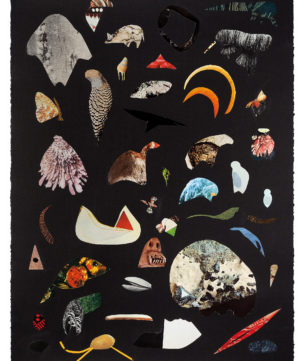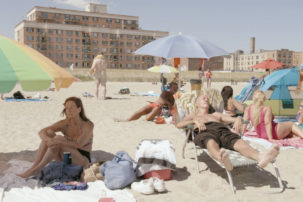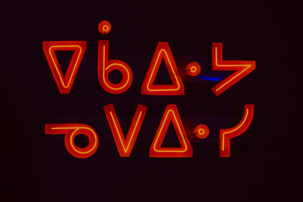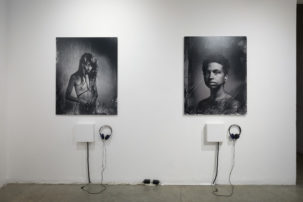In the first scene of Jasmin Mozaffari’s film Firecrackers (2018), Lou’s orange hair and oversized tangerine shirt billow as she pummels another girl in a high school parking lot. Her best friend Chantal’s face moves in and out of frame as she chants encouragement. The scene—a blur of gritty shades and saturated colours in motion—establishes the intensity that runs throughout Mozaffari’s debut feature, steered by expert performances by Michaela Kurminsky and Karena Evans. Firecrackers is set in an unspecified rural Ontario town in the immediate wake of Chantal and Lou’s final year of high school, when unanticipated events thwart their plans to leave for New York. Firecrackers’ aesthetic is composed of glowing gas stations, dimly lit bars, bright red lollipops, crop tops and tearaway track pants. The film’s look is a remnant of a visual trend that defined many films about young people of the post-Instagram, post-Tumblr era: the teenage dream aesthetic. Firecrackers references this filmic look and then turns on it, to show who and what the teenage dream leaves in its wake.
In their 2013 Hyperallergic essay “Bad Girl Criminality and American Teen Dreams,” Alicia Eler and Megan Milks identify two films that they argue epitomized the teen-dream aesthetic: Harmony Korine’s Spring Breakers (2012) and Sophia Coppola’s The Bling Ring (2013). Both were emphatically stylish, inspired by social media’s ability to produce a dream world cast in hyper-saturated neon colours and smudged lighting. These films reflected a growing trend of teen movies that used lighting and colour dramatically to communicate themes of artificiality, celebrity and money. Along these lines, Spring Breakers, in particular, stressed the ways that social media was a tool through which users could transcend social or class markers of offline life. Spring Breakers’ look and feel, full of bright lights, 1990s nostalgia, Lisa Frank acidity, capitalistic bacchanal and hyperbolic (hetero)sexuality, did not age well. The teen-dream aesthetic, however, did reappear in more complex films released shortly after, where it demonstrated a formal trend in the same ways early 2010s cinema grappled with youth popular culture. It Follows (2014), for example, was similarly indulgent of light and colour, while the French film Girlhood (2014) elevated pop music to spiritual strata.
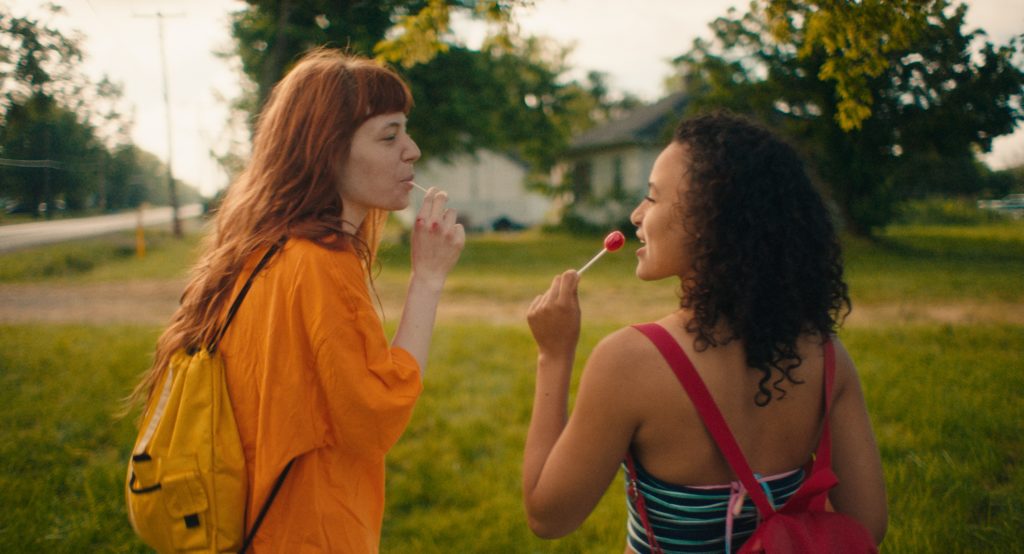
Jasmin Mozaffari, Firecrackers (film still), 2018. 93 min. Courtesy Prowler Film.

Jasmin Mozaffari, Firecrackers (film still), 2018. 93 min. Courtesy Prowler Film.

Jasmin Mozaffari, Firecrackers (film still), 2018. 93 min. Courtesy Prowler Film.
Instagram is now so quotidian that the hyperreal aesthetic of those earlier teen-dream films is dated. Social media has become both more ordinary and more insidious than when Instagram and other photo-sharing apps first crashed onto the scene. No longer sublime, the affective experience of being online runs along a gradient of “big moods,” from banal to empowering to terrifying. As a result, Anglo-American films have shifted their approaches to visualizing young people. Some films have evaded showing the iPhone by setting their stories in a semi-recent history that predates its 2007 release to the market. Ladybird (2017) and The Miseducation of Cameron Post (2018) set their explorations of girlhood in the early 2000s and 1990s, respectively. Certainly stylish and creative in their use of lighting, these types of movies don’t aim to replicate internet aesthetics or feelings. When set in the present or tackling online culture, some films, such as the very recent Eighth Grade (2018) or Skate Kitchen (2018), treat smartphones and social media platforms as objects of everyday life rather than as near supernatural cultural forces. These films acknowledge that social media has shaped the ways teenagers grow up and communicate, but they don’t elevate this experience to catastrophic levels.
Mozaffari makes her audience blisteringly aware of the cruelness inherent in the superficial fantasy of the teenage dream.
Firecrackers takes a third route in visualizing girlhood onscreen, negotiating past and present filmic looks. Mozaffari pinpoints the ways in which the early 2010s rolled out a teen fantasy that has faded like a photograph left out in the sun for too long. Firecrackers balances images of teen pop paraphernalia with spatial bleakness. Characters are frequently shown at a distance: the only figures on an otherwise deserted windy beach, fighting in dead bars, playing around in empty gas stations. Bright colors are slightly faded, clothing is worn out, tongues are dyed with digested candy. In foregrounding Lou and Chantal’s difficulties in leaving their town, Mozaffari directly links the teenage dream aesthetic to the survival struggles of two young, working class teen women and the people they come into contact with. Spring Breakers attempted to critique what it perceived as a violent, empty youth culture through inducing a spectatorial nausea by way of its candy-coated chemical sublime. Ultimately, however, the film ended up marketing and celebrating the synthetic look and objectification it aimed to poke holes in.
Conversely, with Firecrackers, Mozaffari rejects hollow, virtual characters and presents a compassionate approach to her onscreen subjects. By prioritizing story over atmosphere, Mozaffari reveals how the teen dream has not been kind to people like Chantal and Lou. It’s painfully real every time Mozaffari’s characters must confront this reality. In emphasizing this dichotomy between a teenage dream rooted in the image and the impossibility of its fulfillment, Mozaffari foregrounds her interest in representing communities “left behind by globalization.” In Firecrackers, globalization has constructed a promise of life beyond the confines of the community represented onscreen, especially manifested in Lou and Chantal’s dream of moving to New York. Even if they make it, these are not and will never be the girls of Frances Ha or Broad City. Firecrackers instead finds its filmic companionship in the cheap plastic, parking lots and precarious living seen in Andrea Arnold’s American Honey (2016) or Sean Baker’s The Florida Project (2017). Yet despite the ways in which these works foreground a toll on the body and spirit, they also show ways in which marginalized subjects survive, make meaning and sometimes slash holes in leviathan systems of power.
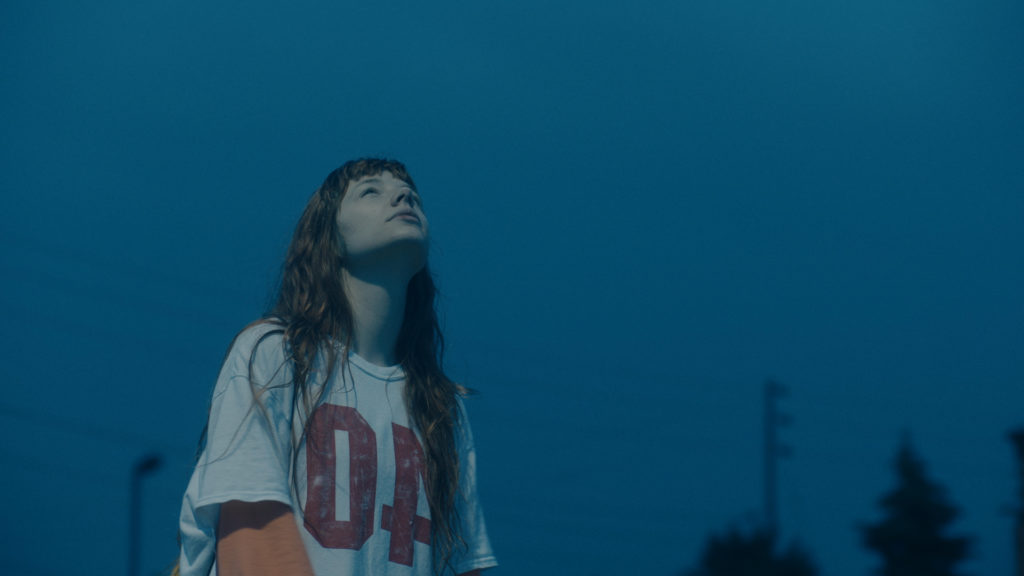 Jasmin Mozaffari, Firecrackers (film still), 2018. 93 min. Courtesy Prowler Film.
Jasmin Mozaffari, Firecrackers (film still), 2018. 93 min. Courtesy Prowler Film.
Mozaffari makes her audience blisteringly aware of the cruelness inherent in the superficial fantasy of the teenage dream. Then, in the final minutes of the film, she switches out that fantasy with a vision of escape that provides much more relief precisely because it isn’t an impossible transcendence. The film’s final image of Lou and Chantal is one we have seen before, two women driving a stolen car down an open road. Their future is a deeply uncertain one. As they exchange looks and push forward, we’re shown a glimpse of what Mozaffari calls “female freedom”—not a packaged or processed image, but liberation animated by the hard momentum of existence.

